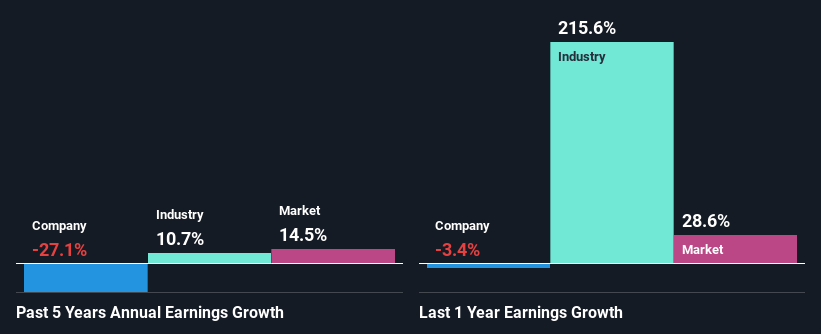Can Australian Unity Office Fund's (ASX:AOF) Weak Financials Pull The Plug On The Stock's Current Momentum On Its Share Price?
Australian Unity Office Fund's (ASX:AOF) stock is up by a considerable 10% over the past week. We, however wanted to have a closer look at its key financial indicators as the markets usually pay for long-term fundamentals, and in this case, they don't look very promising. Specifically, we decided to study Australian Unity Office Fund's ROE in this article.
Return on equity or ROE is an important factor to be considered by a shareholder because it tells them how effectively their capital is being reinvested. In short, ROE shows the profit each dollar generates with respect to its shareholder investments.
See our latest analysis for Australian Unity Office Fund
How Do You Calculate Return On Equity?
The formula for return on equity is:
Return on Equity = Net Profit (from continuing operations) ÷ Shareholders' Equity
So, based on the above formula, the ROE for Australian Unity Office Fund is:
2.3% = AU$10.0m ÷ AU$439m (Based on the trailing twelve months to December 2021).
The 'return' refers to a company's earnings over the last year. One way to conceptualize this is that for each A$1 of shareholders' capital it has, the company made A$0.02 in profit.
Why Is ROE Important For Earnings Growth?
We have already established that ROE serves as an efficient profit-generating gauge for a company's future earnings. Based on how much of its profits the company chooses to reinvest or "retain", we are then able to evaluate a company's future ability to generate profits. Assuming everything else remains unchanged, the higher the ROE and profit retention, the higher the growth rate of a company compared to companies that don't necessarily bear these characteristics.
Australian Unity Office Fund's Earnings Growth And 2.3% ROE
As you can see, Australian Unity Office Fund's ROE looks pretty weak. Not just that, even compared to the industry average of 15%, the company's ROE is entirely unremarkable. For this reason, Australian Unity Office Fund's five year net income decline of 27% is not surprising given its lower ROE. However, there could also be other factors causing the earnings to decline. For example, the business has allocated capital poorly, or that the company has a very high payout ratio.
So, as a next step, we compared Australian Unity Office Fund's performance against the industry and were disappointed to discover that while the company has been shrinking its earnings, the industry has been growing its earnings at a rate of 11% in the same period.
Earnings growth is a huge factor in stock valuation. It’s important for an investor to know whether the market has priced in the company's expected earnings growth (or decline). Doing so will help them establish if the stock's future looks promising or ominous. One good indicator of expected earnings growth is the P/E ratio which determines the price the market is willing to pay for a stock based on its earnings prospects. So, you may want to check if Australian Unity Office Fund is trading on a high P/E or a low P/E, relative to its industry.
Is Australian Unity Office Fund Making Efficient Use Of Its Profits?
Australian Unity Office Fund has a very high three-year median payout ratio of 83%, implying that it retains only 17% of its profits. However, it's not unusual to see a REIT with such a high payout ratio mainly due to statutory requirements. Accordingly, this likely explains why its earnings have been shrinking.
Moreover, Australian Unity Office Fund has been paying dividends for six years, which is a considerable amount of time, suggesting that management must have perceived that the shareholders prefer consistent dividends even though earnings have been shrinking. Upon studying the latest analysts' consensus data, we found that the company is expected to keep paying out approximately 94% of its profits over the next three years. Regardless, the future ROE for Australian Unity Office Fund is predicted to rise to 4.6% despite there being not much change expected in its payout ratio.
Conclusion
On the whole, Australian Unity Office Fund's performance is quite a big let-down. Because the company is not reinvesting much into the business, and given the low ROE, it's not surprising to see the lack or absence of growth in its earnings. That being so, the latest industry analyst forecasts show that the analysts are expecting to see a huge improvement in the company's earnings growth rate. To know more about the company's future earnings growth forecasts take a look at this free report on analyst forecasts for the company to find out more.
Have feedback on this article? Concerned about the content? Get in touch with us directly. Alternatively, email editorial-team (at) simplywallst.com.
This article by Simply Wall St is general in nature. We provide commentary based on historical data and analyst forecasts only using an unbiased methodology and our articles are not intended to be financial advice. It does not constitute a recommendation to buy or sell any stock, and does not take account of your objectives, or your financial situation. We aim to bring you long-term focused analysis driven by fundamental data. Note that our analysis may not factor in the latest price-sensitive company announcements or qualitative material. Simply Wall St has no position in any stocks mentioned.

